Episode 185
What you’ll learn in this episode:
- What to look for when selecting a vintage piece, and why the most important factor is how much you like it
- Why Schreiner jewelry has increased in value, and how to tell if something is a genuine, high-quality piece of Schreiner
- Why online auctions are a great way for new collectors to grow their collection of vintage jewelry
- How Carole started her 40,000-piece collection, and how she allows clients to explore it
- Which emerging and under-appreciated vintage designers you should keep your eye on
About Carole Tanenbaum
Carole Tanenbaum has been collecting costume jewelry for over twenty-five years resulting in an unparalleled collection of over 30,000 pieces dating from the Victorian period to today’s collectibles. Carole Tanenbaum Vintage Collection is one of North America’s premiere collection of vintage costume jewelry. Every piece in the collection has been hand-selected with an eye for design, creativity and exceptional workmanship. The collection integrates vintage costume jewelry as wearable works of art into the fashion world.
As a world-renowned collector, Carole has given a number of lectures on vintage costume jewelry at museums, universities, and social clubs. The collection continues to be featured in a multitude of fashion publications, and film and television productions.
Additional Resources:
Photos:
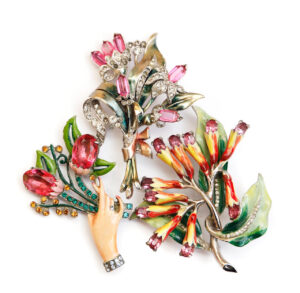
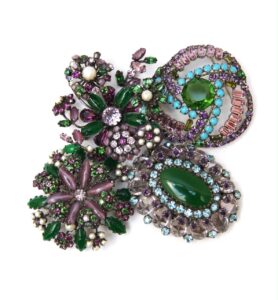

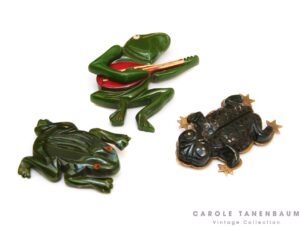
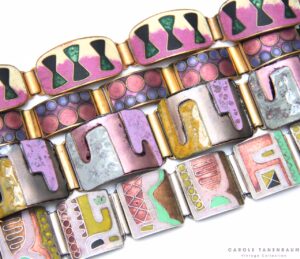
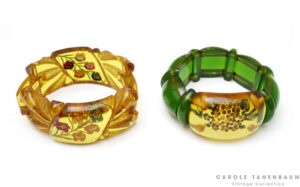
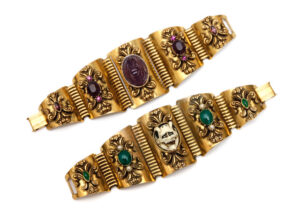
Transcript:
When it comes to vintage costume jewelry, few people can match Carole Tanenbaum’s passion. Her 40,000-piece collection covers the history of costume jewelry from the Victorian era to the 90s, along with some emerging contemporary designers thrown in for good measure. She joined the Jewelry Journey Podcast to talk about her interest in Schreiner jewelry; how she wrote her two books on costume jewelry; and what she looks for when adding to her collection. Read the episode transcript here.
Sharon: Hello, everyone. Welcome to the Jewelry Journey Podcast. This is the first part of a two-part episode. Please make sure you subscribe so you can hear part two as soon as it’s released later this week.
Today, my guest is Carole Tanenbaum speaking to us from Toronto. She and her husband have been collectors of everything, including vintage costume jewelry, for years. She herself has written two books on the subject of vintage costume jewelry. “Fabulous Fakes: A Passion for Vintage Costume Jewelry” is the first one, and the newest one is a book on Schreiner jewelry, “Schreiner: Masters of Twentieth-Century Costume Jewelry.” She must think highly of that. Each week, she holds an auction of vintage costume jewelry, and she’ll tell us all about that. Besides that, we’ll also learn why she focused on vintage costume jewelry and everything they collect, what she looks for in terms of evaluating a piece of vintage jewelry, whether it’s for her own collection or to sell, and how you too can get involved. Carole, welcome to the program.
Carole: Thank you for inviting me. It’s good to be here.
Sharon: So glad to have you. Tell us about your jewelry journey. You collect everything.
Carole: We are collectors of many things. We collect photos. We collect vintage toys, African sculpture. But how you know I loved to antique; we still do. When we were in London in the 70s, I came upon a collection of fantasy jewelry, jewelry that wasn’t gemstone, but it had the most beautiful vision to me aesthetically. I was hooked, and I bought about 20 pieces at that time. I always know when it will go forward, so it wasn’t just a one-shot deal that started me in collecting.
Sharon: Had you been attracted to glittery things or colorful things before that?
Carole: I love fashion, and I’ve always loved the wow factor in fashion. The collection I saw was large pieces, so immediately I responded to it as things I could wear and love and feel really shi-shi in them. I bought the pieces I loved. There were about 50 pieces, and I was very discerning. I always know what I want to have. That was my first experience of hundreds. I have about 40,000 pieces.
Sharon: Did you buy the first 20 or 50 from the same person, or was this from several people?
Carole: No, it was from the same person. In the 70s, vintage costume jewelry wasn’t really a collectable. It was a throwaway, so there weren’t many dealers to choose from. This one person who had them really had the only great pieces of jewelry in the whole show, other than gemstone jewelry. I was lucky that I was able to focus on this one person. I still have a couple of those pieces in my private collection.
Sharon: Wow! Did you recognize right away that it was being ignored and that it was going to be collectable?
Carole: No, I didn’t care. For me, they were objects d’art. I never am influenced by what’s in and what’s out. I trust my eye. When I did see this collection, I knew I had to have them, that they were beautiful and highly collectable despite what was happening universally.
Sharon: Did you own, I’ll say, “regular” gems? Was this a way to wear something and if you list it, it was not a big deal?
Carole: It was always a big deal for me. Everything we collect, whether it was $2 or $20,000, has the same weight aesthetically to us. My husband has bought me some wonderful, real Deco jewelry, big, chokey necklaces, but gemstone. I always loved those because it was still my aesthetic. But when I started this collection, it showed that these pieces have the same wow and the same effect on me as gemstone, and I started looking and researching. Very few books were written on the subject in the 70s, but I started looking at the pieces that were being offered by the theater, by movies, by starlets, etc. I realized it’s a field I wanted to start collecting. I realized that very early on after I bought these pieces.
Sharon: Did you have the support of your husband that this is art?
Carole: I always have the support of my husband. I’m a very lucky woman. Actually, we share our loves of whatever we collect. He’s a great collector of Daguerreotypes. Whenever we’re at the antique shows, I hunt for those as well as for what I love. We always share our collections as one collection. In fact, Howie will run around the show, or used to run around the shows, and he would come over to me, “Carole, come here. I have to show you something at this other dealer’s showcase.” I would go there and I would love what he picked.
Sharon: So, you don’t go to as many shows as you used to, it sounds like.
Carole: Since Covid, I have to tell you it’s very small pickings. I go to whatever is available, but now the market has changed completely. Whenever I can, I go to shows. I go to shows in the outskirts of New York, sometimes to the New York Metropolitan Show and some of the local shows here. Oftentimes I get lucky, but I don’t get the breadth of pieces I had earlier on.
Sharon: Since Covid, I found I’ve been really hungry for shows. I go to whatever there is. Do you find that a lot of people have moved online?
Carole: That’s a very good question, Sharon, because now, the way to buy vintage costume jewelry is on Facebook. There are about 40 different people who have weekly shows. I don’t have weekly shows of that auction. I don’t have the patience for it. It’s not a part of my business, but I go to the shows that are online. There are people who went to a country show to show their fare and don’t have an outlet, so they’re doing it at their home. Oftentimes you can get very lucky with that. They sometimes don’t know what they have, and since it’s an auction, you might be lucky. For people who are starting now, it’s a great way to develop a collection, Sharon, because you have the world at your shoulders.
Sharon: Let me back up. You said there weren’t many books on the subject. Is that what brought you to write a book about it?
Carole: No, that’s a different story. When you start asking me about how I became a businesswoman, that’s one of the ways I started. I’ll tell you about that journey.
Sharon: Do you find that the jewelry in Canada and Toronto is different than what you find elsewhere in New York or when you’re at smaller shows?
Carole: It’s on a lower scale, number one. You’re less able to find something in Canada—although the search is always as important to me as the sale—than you would be in New York or Boston or any of the big cities. Oftentimes, I will go to a major city, rent a car and go to the peripheral areas. There you can find antique stores and go in, and you know you’re going to find that masterpiece. The search is a lot of fun. When you find something, of course it’s glorious.
Sharon: I bet it would be. That’s interesting. I never thought of Boston. I always think of the east coast as New York and the south. They say there’s nothing out in Los Angeles or on the west coast, but on the east coast, Boston just doesn’t occur to me.
Carole: Boston is a very interesting city because it’s a university city. It’s a city where the university kids go looking for bargains. They have one major store on their street. I don’t remember the street that has floor-to-ceiling vintage. That’s a place that people go. When I go, I go there, then I go to Cambridge, and then I go to the outskirts of it, Quincy or some of the other places. You never know what you’re going to find. Sometimes it’s a bust, but other times, I’ve found some wonderful pieces.
Sharon: Does your husband come with you?
Carole: Yeah, because he’s also looking, don’t forget. He’s a collector, and he’s looking for other things we collect. He’s also looking for my welfare, what would I like. He knows my style; he knows my eye. Oftentimes when he says, “You have to look here,” he’s right on.
Sharon: Wow! I’m surprised to hear you say it. It sounds like it’s not too late to start.
Carole: It’s not too late to start. It’s more expensive to start if you’re looking for the high-end pieces. For example, when I started collecting Schreiner, my average price of Schreiner was between $150 and $300. Now, these pieces go for $10,000.
Sharon: Wow! We’ll have a picture when we post this. It’s gorgeous.
Carole Those are called ruffle pins. They started at maybe $250, and I only bought them because I loved them. I wear three together, but when I saw that they’re now going at auction for $10,000—they’re the most coveted piece of Schreiner. They’re called ruffle pins.
Sharon: Is Schreiner marked?
Carole: Many of them are marked and many of them aren’t marked. There’s a wonderful group on the internet. By the way, Sharon, I learn so much every day on the internet. A young collector will learn a lot by going through different sites on the internet. I’d be happy to share some of them with you.
But the signature of Schreiner. When Schreiner started going into the stores, he would not use the signature on many pieces because the stores wanted to use their signatures on the pieces. When he worked for the couturiers in the 40s, they wanted their names on the pieces. So, there’s 50% that are signed and 50% that are not signed. The pieces that are not signed are now verified by the Schreiner Group, which is a group on the internet of experts in the field, people who, like myself, have been collecting Schreiner for 30 and 40 years. They’re verified by a group of three collectors. So, each piece that is shown to them is on their database when it is a Schreiner. You’re not fishing; you’re not looking in the dark for a signature. You actually know it by the actual designer.
Sharon: Would you know it by the way it’s made? Are they made better? Are they made differently?
Carole: They’re made as fine gemstone jewelry is made. There’s never any discoloration. The metalwork is marvelous. He was really fanatic with that. The constructions are so intricate that they can’t be copied, so you’re safe when you look at it. If you look at the back of the Schreiner, oftentimes it’s as beautiful as the front. You get to know what to look for in the setting. Are the prongs the right prongs for Schreiner? You can do that with other designers like Kramer or Weiss. They have specific prongs, so you learn how to recognize what is or what isn’t by a designer if you’ve seen enough of it.
Sharon: It seems like every time I go to a show, there are things that say Schreiner or Weiss, the big names, and no marks. Is there anything left to find?
Carole: Yes, there’s a lot left to find. Most of it is unsigned, but again, you’re very confident once you ask the group if it’s a valid Schreiner. Most of the time, they’ll answer you almost immediately. If they have any doubts, they’ll discuss it and look at it in detail and decide whether or not it is a Schreiner. You have to buy what you love. I bought Schreiner because to me, as we are collectors of art, we think Schreiner is a work of art.
Everybody has different tastes. There are collectors of Weiss who know exactly what stones Weiss uses so those are easy for them to know, but sometimes if the Weiss is not signed, other people just have to enjoy the aesthetics. My message is that I always look at the aesthetics first. If the piece pleases me, if I love the design, if the quality is great and it’s not repurposed, it’s a piece I would buy.
Sharon: When you say repurposed, what do you mean?
Carole: In jewelry now, people are taking the liberty of adding to pieces to enhance them. Of course, it destroys the value of them because no matter how great the finished project is, it’s not a Schreiner; it’s not a Schiaparelli; it’s not Chanel. We call it repurposed because some collectors today love those pieces and they collect only repurposed, but I won’t touch these pieces.
Sharon: I’m laughing because somebody please explain to me why Chanel is so expensive. I don’t get it. You mentioned three qualities you look for, whether it’s for your costume jewelry, your collection or other people. You say it’s originality.
Carole: First and foremost, it has to please you. Whether you’re buying a $10 piece or you’re buying a $10,000 piece, it has to appeal to you. You have to know you love it; that’s first of all. Then, second of all, the workmanship. If it’s fine workmanship, meaning if the gold tone is clear and not murky, that’s a good sign. I try to buy pieces that are clean. I call them clean because there’s no imperfection on the metalwork.
Then the things I look for are that they’re not soldered, because the soldered pieces have a tendency to be weak in that area. Even the greatest soldered pieces, in my opinion, could come apart, and I would rather pass on those pieces and look for something that is in fine condition. Then the peeling of pearls. If you’re finding pearls and you’re a pearl collector, you have to look carefully because a lot of the vintage pearls peel. I wouldn’t buy a necklace unless I knew a great restorer who has those colors in pearl. Then, the original stones are very important to me. There are a lot of great repair people out there that have a breadth of stones. They can restore many pieces that are missing stones, but they have to be perfect. If they’re not perfect, an expert can always tell. If I’m selling a piece, I would like it to be perfect in that sense, or I would like the repair person I use to have it perfectly set. That’s another thing.
Then there are no missing parts. That’s another thing. This is an interesting story, and maybe a lesson to beginners. About 30 years ago, I found a wonderful piece of what I considered Reja. I was an Indian piece, a figaro with dangelis. I felt so lucky. It was the most beautiful Reja I ever saw. I learned that if something looks too good to be true, it generally is. I found out afterwards that the dangelis were added. So, it was a very good lesson to me. Sometimes when you look at piece, there’s something about it that doesn’t sit right to you. Ask questions to the dealers. They’re honest generally. If they don’t know, they’ll say, “I don’t know,” and then it’s up to you to research.
Sharon: That’s really interesting. It sounds like you’ve looked at a million and one pieces. I was under the impression that your auctions were weekly. When I say get rid of it—if you have 40,000 pieces—
Carole: No, but what I do occasionally is deaccession my earlier pieces through a couple of the national and international auctions I trust. I do that because if they’re sitting in my drawers and not doing anything, it’s not that I lost respect for them, it’s that I want other people to enjoy them. So, I would say twice a year, I have an auction at Ripley’s Auction, I have an auction here at Waddington’s Auction. When we were selling our toys, because we’re at an age now where you have to start thinking about where these things are going, I did it at Miller and Miller in Canada, a wonderful auction house. Those are the types of auctions and that’s the reason why I do them, but they’re only occasional. I always post them on my different sites so the public is aware of them.
Sharon: Where do you find the pieces you do buy? Just looking around and going to these places on the outskirts?
Carole: First of all, we are very fortunate because people know my name. They know about me, so they have offered pieces on many occasions. I’m even buying back pieces from people who don’t wear them anymore and want them passed back to me, but I would say that’s just by happenstance. We love antiquing, so it doesn’t matter whether we find or we don’t find. It’s getting much harder, as I told you, because there are fewer outlets. A lot of the small antique dealers went under and don’t have places where they can show their pieces other than the net. I do think the net now is the best place to look outside of shopping for them, but if you’re shopping for them, don’t have high hopes, because the very high end is being bought out by savvy collectors.
Sharon: We will have photos posted on the website. Please head to TheJewelryJourney.com to check them out.

